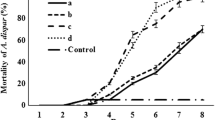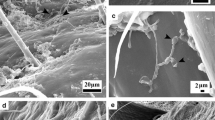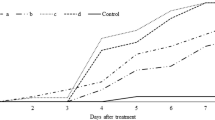Abstract
The bark beetle, Ips stebbingi Strohmeyer (Coleoptera: Curculionidae: Scolytinae) is one of the most serious pests of Pinus wallichiana A. B. Jacks (Pinaceae) in Kashmir Himalaya. In order to find an effective biocontrol agent against this pest, we determined the effectiveness of entomopathogenic fungi, viz. Beauveria bassiana (Balsamo) Vuillemin, Metarhizium anisopliae sensu lato (Metchnikoff) Sorokin, and Lecanicillium lecanii (Zimmerman) Zare et Gams against I. stebbingi in the laboratory conditions. Each fungal suspension contained 1.0 × 109 spores of fungi in 1 ml. The insecticide (cyclone 505 EC) was also used as positive control in the experiment. The mortality caused with these fungi was recorded in treated branches and Petri dish assay. In treated branches, B. bassiana and M. anisopliae caused higher mortality, i.e., 68% and 71.25%, respectively, 10 days after treatment, and 93.10% and 88%, respectively, 20 days after treatment. The results of Petri dish assay revealed that I. stebbingi adults were highly susceptible to both treated fungal species and insecticide. However, B. bassiana and M. anisopliae caused higher percentage mortality six days after treatment, i.e., 94.16% and 100% respectively. The percentage of mortality caused by treating with insecticide was 60%. Lecanicillium lecanii was found significantly less virulent (mortality 18.33%) in all fungal treatments. Results obtained in the present study are promising and may be used as alternative means of chemical control for management of this beetle pest; however, no recommendations concerning the potential use of these fungal pathogens for forest protection can be given, and further studies are needed in this respect, especially under field conditions.
Similar content being viewed by others
References
Bałazy, S., “The Fungus Cephalosporium (Acrostalagmus) lecanii Zimm., a Pathogen of Beetle Larvae,” Acta Societatis Botanicorum Poloniae 32, 69–80 (1963).
Bałazy, S., “Living Organisms Regulating Population Density of Bark Beetles in Spruce Forests, with Special Reference to Entomopathogenic Fungi,” Poznanskie Towarzystwo Przyjaciol Nauk Wydzial Nauk Rolniczych i Lesnych 21, 3–50 (1966).
Barson, G., “Laboratory Studies on the Fungus Verticillium lecanii, a Larval Pathogen of the Large Elm Bark Beetle (Scolytus scolytus),” Annals of Applied Biology 83, 207–214 (1976).
Barson, G., “Laboratory Evaluation of Beauveria bassiana as a Pathogen of the Larval Stage of the Large Elm Bark Beetle, Scolytus scolytus,” Journal of Invertebrate Pathology 29, 361–366 (1977).
Batta, Y.A., “Biocontrol of Almond Bark Beetle (Scolytus amygdali Geurin-Meneville, Coleoptera: Scolytidae) Using Beauveria bassiana (Bals.) Vuill. (Deuteromycotina: Hyphomycetes),” Journal of Applied Microbiology 103 (5), 1406–1414 (2007).
Buhroo, A.A. and Lakatos, F., “Molecular and Morphological Diagnostic Markers for the Himalayan Ips DeGeer Species (Coleoptera: Curculionidae: Scolytinae),” Zootaxa 3128, 47–57 (2011).
Grodzki, W. and Kosibowicz, M., “An Attempt to Use the Fungus Beauveria bassiana (Bals.) Vuill. in Forest Protection Against the Bark Beetle Ips typographus (L.) in the Field,” Forest Research Papers 76, 5–17 (2015).
Grosman, D.M. and Upton, W.W., “Efficacy of Systemic Insecticides for Protection of Loblolly Pine Against Southern Pine Engraver Beetles (Coleoptera: Curculionidae: Scolytinae) and Wood Borers (Coleoptera: Cerambycidae),” Journal of Economic Entomology 99 (1), 94–101 (2006).
Jakus, R. and Blazenec, M., “Treatment of Bark Beetle Attacked Trees with Entomopathogenic Fungus Beauveria bassiana (Balsamo) Vuillemin,” Folia Forestalia Polonica, Series A. Forestry 53, 150–155 (2011).
Khanday, A.L. and Buhroo, A.A., “Life History and Biology of the Elm Bark Beetle Scolytus kashmirensis Schedl (Coleoptera: Curculionidae: Scolytinae) Infesting Ulmus villosa in Kashmir,” Open Journal of Forestry 5, 443–453 (2015).
Kreutz, J., Vaupel, O., and Zimmermann, G., “Efficacy of Beauveria bassiana (Bals.) Vuill. Against the Spruce Bark Beetle, Ips typographus L., in the Laboratory Under Various Conditions,” Journal of Applied Entomology 128, 384–389 (2004).
Liu, H. and Bauer, L.S., “Susceptibility of Agrilus planipennis (Coleoptera: Buprestidae) to Beauveria bassiana and Metarhizium anisopliae,” Journal of Economic Entomology 99, 1096–1103 (2006).
Markova, G., “Pathogenicity of Several Entomopathogenic Fungi to Some of the Most Serious Forest Insect Pests in Europe,” IOBC/WPRS Bulletin 23 (2), 231–239 (2000).
Markova, G. and Samshinyakova, A., “Laboratory Studies on the Effect of the Entomopathogenic Fungus Beauveria bassiana on Larvae of Lymantria dispar,” Nauka za Gorata 27, 81–84 (1990).
Mudroncekova, S., Mazan, M., Nemcovic, M., and Salomon, I., “Entomopathogenic Fungus Species Beauveria bassiana (Bals.) and Metarhizium anisopliae (Metsch.) Used as Mycoinsecticide Effective in Biological Control of Ips typographus (L.),” The Journal of Microbiology, Biotechnology and Food Sciences 2, 2469–2472 (2013).
Novak, V. and Samsinsakova, A., “Les essais d’aplication du champignon parasite Beauveria bassiana (Bals.) Vuill. dans lalutte contreles parasites en agriculture et sylviculture en CSSR,” Colloques Internationaux de Pathologique des Insectes, Paris, 133–135 (1962).
Pfeffer, A., “Zentral-und Westpaläarktische Borken und Kernkäfer,” Pro Entomologia, c/o Naturhistorisches Museum Basel, 310 (1995).
Postner, M., “Scolytidae (= Ipidae), Borkenkäfer,” in Die Forstschädlinge Europas, Bd. 2 Ed. by Schwencke, W., (Paul Parey Verlag, Hamburg, Berlin, 1974), pp. 334–482.
Raffa, K.F., Aukema, B.H., Bentz, B.J., Carroll, A.L., Hicke, J.A., and Kolb, T.E., “Responses of Tree-Killing Bark Beetles to a Changing Climate,” in Climate Change and Insect Pests, Ed. by Bjorkman, C. and Niemela (CABI, Oxfordshire, 2015), pp. 173–201.
Schmutzenhofer, H., “Mass Outbreaks of Ips Bark Beetles in Bhutan and the Revision of the Genus Ips de Geer for the Himalayan Region,” in Integrated Control of Scolytid Bark Beetles, Ed. by Payne, T.L. and Saarenmaa, H. (Virginia Polytechnic Institute and State University, Blacksburg, Virginia,1988), pp. 345–355.
Steinwender, B., Krenn, H., and Wegensteiner, R., “Different Effects of the Insect Pathogenic Fungus Beauveria bassiana (Deuteromycota) on the Bark Beetle Ips sexdentatus (Coleoptera: Curculionidae) and on Its Predator Thanasimus formicarius (Coleoptera: Cleridae),” Journal of Plant Diseases and Protection 117, 33–38 (2010).
Tanyeli, E., Sevim, A., Demirbag, Z., Eroglu, M., and Demir, I., “Isolation and Virulence of Entomopathogenic Fungi Against the Great Spruce Bark Beetle, Dendroctonus micans (Kugelann) (Coleoptera: Scolytidae),” Biocontrol Science and Technology 20, 695–701 (2010).
Tshering, G. and Chhetri, D.B., “Important Forest Insect Pests and Diseases of Bhutan with Control Measures,” in Renewable Natural Resources Research Centre, Yusipang, Bhutan and Natural Resources Training Institute, Lobesa, Bhutan. MoA, Field Guide (2000), vol. 1, p. 57.
Wegensteiner, R., “Laboratory Evaluation of Beauveria bassiana (Bals.) Vuill. Against the Bark Beetle, Ips typographus (L.) (Coleoptera, Scolytidae),” Bulletin OILB/SROP 19, 186–189 (1996).
Wegensteiner, R., “Pathogens in Bark Beetles,” in Bark and Wood Boring Insects in Living Trees in Europe, a Synthesis (Springer, The Netherlands, 2007), pp. 291–313.
Wood, S.L. and Bright, D.E., “A Catalog of Scolytidae and Platypodidae (Coleoptera),” Part 2: Taxonomic Index, Volumes A and B. Great Basin Natural Memoirs 13, 1–1553 (1992).
Zhang, L.W., Liu, Y.J., Yao, J., Wang, B., Huang, B., Li, Z.Z., Fan, M.Z., and Sun, J.H., “Evaluation of Beauveria bassiana (Hyphomycestes) Isolates as Potential Agents for Control of Dendroctonus valens,” Insect Science 18, 209–216 (2011).
Zimmermann, G., “Review on Safety of the Entomopathogenic Fungi Beauveria bassiana and Beauveria brongniartii,” Biocontrol Science and Technology 17, 553–596 (2007).
Author information
Authors and Affiliations
Corresponding author
Additional information
This article was originally submitted by the authors in English and is first published here.
Rights and permissions
About this article
Cite this article
Khanday, A.L., Buhroo, A.A., Ranjith, A.P. et al. Evaluating the Efficacy of Entomopathogenic Fungi against the Bark Beetle, Ips stebbingi Strohmeyer (Coleoptera, Curculionidae: Scolytinae) in India. Entmol. Rev. 98, 985–994 (2018). https://doi.org/10.1134/S0013873818080055
Received:
Revised:
Accepted:
Published:
Issue Date:
DOI: https://doi.org/10.1134/S0013873818080055




